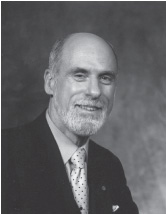访谈: Vinton G. Cerf#
Interview: Vinton G. Cerf
Vinton G. Cerf 是 Google 的副总裁兼首席互联网传播大使。他曾在 MCI 公司任职超过 16 年,最终担任技术战略高级副总裁。他因共同设计 TCP/IP 协议及互联网架构而广为人知。在 1976 至 1982 年间,他在美国国防部高级研究计划局(DARPA)工作,期间在互联网及其相关数据包与安全技术的发展中发挥了关键作用。他于 2005 年获得美国总统自由勋章,1997 年获得美国国家技术奖章。他拥有斯坦福大学数学学士学位,以及加州大学洛杉矶分校(UCLA)计算机科学硕士和博士学位。

Vinton G. Cerf is Vice President and Chief Internet Evangelist for Google. He served for over 16 years at MCI in various positions, ending up his tenure there as Senior Vice President for Technology Strategy. He is widely known as the co-designer of the TCP/IP protocols and the architecture of the Internet. During his time from 1976 to 1982 at the US Department of Defense Advanced Research Projects Agency (DARPA), he played a key role leading the development of Internet and Internet-related data packet and security techniques. He received the US Presidential Medal of Freedom in 2005 and the US National Medal of Technology in 1997. He holds a BS in Mathematics from Stanford University and an MS and PhD in computer science from UCLA.

是什么促使您专攻网络领域?#
What brought you to specialize in networking?
20 世纪 60 年代末,我在 UCLA 担任程序员工作。我的职位由美国国防高级研究计划局(当时称为 ARPA,现在称为 DARPA)资助。我在 Leonard Kleinrock 教授的实验室中从事新建立的 ARPAnet 网络测量中心的工作。ARPAnet 的第一个节点于 1969 年 9 月 1 日安装在 UCLA。我负责编写程序,用于捕捉 ARPAnet 的性能信息,并将这些信息报告出来,以便与该网络性能的数学模型和预测进行比较。
我们几个研究生被指定负责开发所谓的 ARPAnet 主机层协议 —— 即允许网络中各种不同类型的计算机能够互相通信的过程和格式。对我来说,这是一场探索分布式计算与通信新世界的迷人之旅。
I was working as a programmer at UCLA in the late 1960s. My job was supported by the US Defense Advanced Research Projects Agency (called ARPA then, called DARPA now). I was working in the laboratory of Professor Leonard Kleinrock on the Network Measurement Center of the newly created ARPAnet. The first node of the ARPAnet was installed at UCLA on September 1, 1969. I was responsible for programming a computer that was used to capture performance information about the ARPAnet and to report this information back for comparison with mathematical models and predictions of the performance of the network. Several of the other graduate students and I were made responsible for working on the so-called
host-level protocols of the ARPAnet—the procedures and formats that would allow many different kinds of computers on the network to interact with each other. It was a fascinating exploration into a new world (for me) of distributed computing and communication.
当您第一次设计该协议时,您是否曾想象过 IP 会像今天这样普及?#
Did you imagine that IP would become as pervasive as it is today when you first designed the protocol?
当 Bob Kahn 和我在 1973 年最初从事这项工作时,我们最关注的是一个核心问题:在无法改变网络自身的前提下,如何使异构分组网络能够互操作?我们希望能找到一种方式,使任意集合的分组交换网络能够透明地互联,以便主机之间能够端到端通信,而无需在中间进行任何转换。我想我们当时知道我们正在处理的是一种强大且可扩展的技术,但我怀疑我们是否清晰地预见到如今有数亿台计算机互联在互联网上的世界。
When Bob Kahn and I first worked on this in 1973, I think we were mostly very focused on the central question: How can we make heterogeneous packet networks interoperate with one another, assuming we cannot actually change the networks themselves? We hoped that we could find a way to permit an arbitrary collection of packet-switched networks to be interconnected in a transparent fashion, so that host computers could communicate end-to-end without having to do any translations in between. I think we knew that we were dealing with powerful and expandable technology, but I doubt we had a clear image of what the world would be like with hundreds of millions of computers all interlinked on the Internet.
您现在对网络和互联网的未来有何展望?您认为它们的发展将面临哪些主要挑战/障碍?#
What do you now envision for the future of networking and the Internet? What major challenges/obstacles do you think lie ahead in their development?
我相信互联网本身以及网络总体将继续迅速发展。已有有力证据表明,互联网上将连接数十亿台启用了网络功能的设备,包括手机、冰箱、个人数字助理、家庭服务器、电视机,以及常见的笔记本、服务器等。主要挑战包括对移动性的支持、电池寿命、接入网络链路的容量,以及将光纤核心网络无限扩展的能力。
我目前正积极参与在喷气推进实验室(JPL)进行的一个项目 —— 设计互联网的星际扩展。我们还需要从 IPv4(32 位地址)迁移到 IPv6(128 位地址)。挑战清单还很长!
I believe the Internet itself and networks in general will continue to proliferate. Already there is convincing evidence that there will be billions of Internet-enabled devices on the Internet, including appliances like cell phones, refrigerators, personal digital assistants, home servers, televisions, as well as the usual array of laptops, servers, and so on. Big challenges include support for mobility, battery life, capacity of the access links to the network, and ability to scale the optical core of the network up in an unlimited fashion. Designing an interplanetary extension of the Internet is a project in which I am deeply engaged at the Jet Propulsion Laboratory. We will need to cut over from IPv4 [32-bit addresses] to IPv6 [128 bits]. The list is long!
谁在职业上给予了您启发?#
Who has inspired you professionally?
我的同事 Bob Kahn;我的论文导师 Gerald Estrin;我最好的朋友 Steve Crocker(我们在高中时相识,是他在 1960 年把我引入计算机世界!);以及今天仍在不断推动互联网发展的成千上万位工程师们。
My colleague Bob Kahn; my thesis advisor, Gerald Estrin; my best friend, Steve Crocker (we met in high school and he introduced me to computers in 1960!); and the thousands of engineers who continue to evolve the Internet today.
您对进入网络/互联网领域的学生有什么建议吗?#
Do you have any advice for students entering the networking/Internet field?
跳出现有系统的局限去思考 —— 想象可能实现的事情;然后再付出努力,从当前状态出发,一步一步实现你的目标。要敢于梦想:我和喷气推进实验室的六位同事一直在设计地球互联网的星际扩展。这一过程可能需要几十年才能逐个任务地实现,但套用一句话:“人的志向应超越当下所能掌握之物,否则天穹的存在又有何意义?”
Think outside the limitations of existing systems—imagine what might be possible; but then do the hard work of figuring out how to get there from the current state of affairs. Dare to dream: A half dozen colleagues and I at the Jet Propulsion Laboratory have been working on the design of an interplanetary extension of the terrestrial Internet. It may take decades to implement this, mission by mission, but to paraphrase: “A man’s reach should exceed his grasp, or what are the heavens for?”